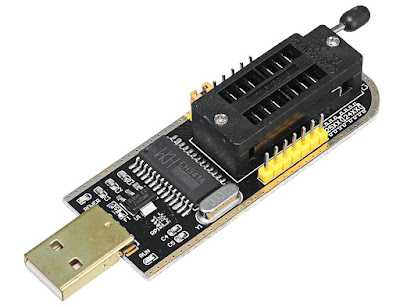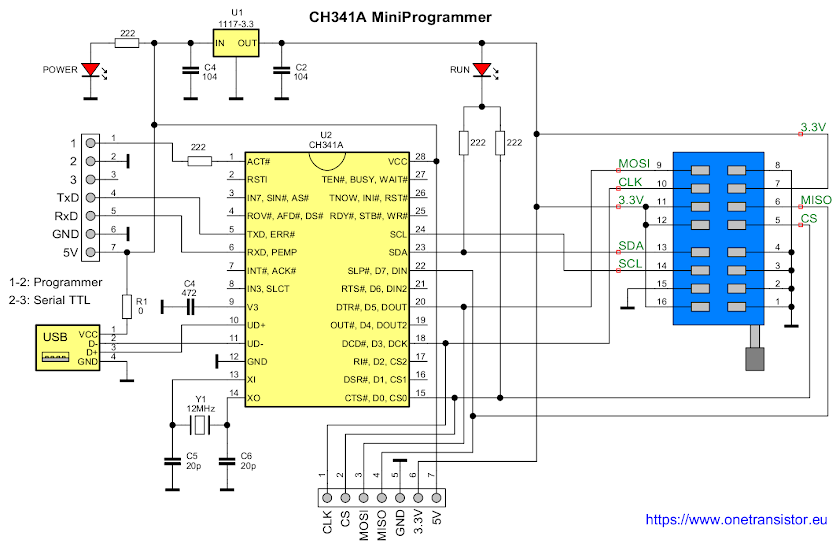CH341A Mini Programmer Schematic and Drivers
Take a look at the schematic of this versatile programmer to learn how to use it properly. An overview of CH341A devices with driver and tools download links
CH341A is an USB interface chip that can emulate UART communication, standard parallel port, memory parallel port and synchronous serial (I2C, SPI). The chip is manufactured by Chinese company Jiangsu QinHeng Ltd. CH341A is used by some cheap memory programmers. The IC is somehow limited in this configuration, because the programmer makes use only of the SPI and I2C interface and leaves a lot of pins unconnected. A popular device is the black CH341A MiniProgrammer that you can buy for 2 to 5 USD.
The problem with these devices is that you get them without any documentation or software. Drivers are available from manufacturer’s website (but the site is written in Chinese). Also, some source codes are available from manufacturer. There are open source applications that support this programmer. But, first of all, let’s have a look at the hardware.

Photo of the black CH341A Mini Programmer
A quick look at the board reveals the main electronic parts used: CH341A, a 12 MHz crystal required by the chip, a 3.3V regulator, two 7 pin headers and the ZIF (zero insertion force) socket. The programmer can be bought with additional sockets and adapters, some of them with voltage shifting circuits.
Mục lục bài viết
Schematic
After some searching I found a schematic of a CH341A based programmer, but it wasn’t exactly right and complete. It didn’t have the pinheaders on the sides of the ZIF socket which I wanted to know what they are for. I took the multimeter and started to trace lines on the programmer PCB until I got a complete schematic. The schematic is quite simple, based on datasheet.

Schematic of the black CH341A Mini Programmer
I also found WAVGAT store (a seller on AliExpress). Their product page offered a the PCB design of the device (only top side, however).

CH341A Mini Programmer PCB (by WAVGAT/AliExpress)
Now, let’s return to the schematic and analyze it a bit. The chip is powered from 5V, so its I/O ports will also use 5V. Basically this is a 5V device. The problem is that any memory you fit in the socket will be powered from 3.3V. And this seems to be the only function of the 3.3V regulator (besides the 3.3V pin on the SPI connector). I don’t know why the designer even used a regulator, if it didn’t provide a switch to choose between 3.3V or 5V levels and supply.
By reading the datasheet, we can see that the manufacturer recommended to connect a 0.47 uF capacitor between RSTI (pin 2) and VCC for improved stability. There is none on this board.
Anyway, I used the device with I2C EEPROMS (3.3V and 5V) compatible and also SPI FLASH memories (3.3V devices) without any issues. For improved reliability and to avoid burning memory chips, I highly recommend using a level shifter. In order to turn this programmer into a 3.3V device, you could cut the 5V line from VCC pin (28) and tie it to the 3.3V output from regulator. You will also need to connect V3 pin (9) to VCC (3.3V). User johnmx from EEVblog Forum has succeeded in converting this programmer to 3.3V levels.
Note that the device works as a programmer only if ACT# pin is connected to ground via a resistor. That’s why you should put a jumper across pins 1 and 2 of the UART connector. Otherwise the device will be recognized as a standard USB to serial converter.
Drivers and tools
The manufacturer of CH341A provides a lot of useful things on the product page. Here are the files you can find and what they contain (the first two are the ones you need):
- CH341SER.EXE – self installing archive with USB to serial driver.
- CH341PAR.EXE – self installing archive with multiprotocol interface driver (this one is for the programmer mode)
- CH341SER.ZIP – archive containing driver files and serial API and library (you don’t need specific API for standard serial port, but it contains some special functions to get IC version etc.)
- CH341PAR.ZIP – archive containing driver files for interface mode and API (header and library to access the device and use any protocol you want).
- CH341PAR_LINUX.ZIP – archive containing Linux driver source code and Linux API
- CH341SER_LINUX.ZIP – Linux driver source code for serial port (don’t need this one, it’s already included in kernels)
- CH341EVT.ZIP – some source code and tools written to be used with an evaluation board (may be useful for programming software that can access this device)
- CH341DS1.PDF – datasheet, in Chinese
- CH341DS2.PDF – some additional info and API documentation, in Chinese
- CH341DP.ZIP – contains an ISP programming tool?
- CH341DPS.ZIP – probably similar to the above, once required login to download
A regular user only needs the first two. Just double click on each of them and when the dialog appears click on Install. Next thing you’ll need is software. Windows users can try AsProgrammer.
The API becomes interesting due to the versatility of the chip. You can build your own software that will read/write data from/to sensors, real time clocks or any other devices that use serial communication. You can also interface parallel devices to the chip, but this will require modification of the programmer board in order to connect to pins.
CH341A devices
There are also some other programmers and boards based on this chip. You can find most of them by searching “CH341A” on Banggood and AliExpress. Here is an overview of the programmers and development boards available:

CH341A Programmers and boards overview
Further reading (for developers): I2C Programming and SPI Programming using Windows API.











